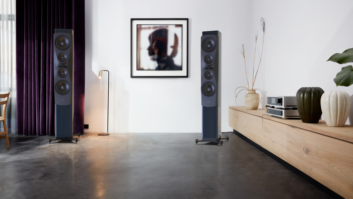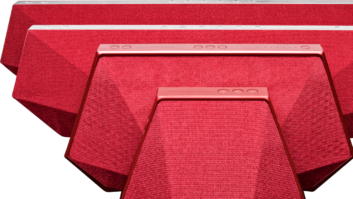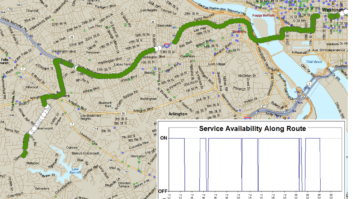More hi-fi WiFi
Jul 1, 2004 12:00 PM
Nice editorial in the June issue [When hi-fi meets WiFi]. In addition to the relatively slow national roll-out of broadband, the user interface on all Internet appliances needs serious help. Users require the ability to seek programming content on the Internet in as easy a fashion as it is to punch a button on a radio or television remote control.
Last week I ordered and received a new Linksys audio media adapter. This unit essentially picks up where Kerbango left off. Initial provisioning of the Linksys unit was far too complex � and my networking skills are excellent.
Once the unit was provisioned and streaming, searching for local network hard drive content and available Internet stations was an absolutely painful experience. Finally, I gave up and sent it back for a refund.
The concept of Internet multimedia portability is a good one. Access to high-speed networks via WiFi and wired connections is becoming more prevalent every passing day, giving users the ability to watch and listen a wide variety of programming choices. But until my grandmother can make use of these devices without requiring CBNT certification, the companies who manufacture Internet appliances are destined to keep failing.
Paul Christensen, CPBE
attorney
Jacksonville, FL
DRM, the other IBOC
I really liked your DRM coverage [in the May 26 issue of the IBOC Update e-mail newsletter]. I would like to point out that depending on the mode DRM is capable of more than 24kb/s. In a 20kHz channel and low interference, the rate could be as high as 72kb/s. The DRM specification permits user selection of either 16 or 64 QAM modulation, channel bandwidth and error correction as well as three types of audio coding, ACC SBR being used at normal data rates. Modulation type and error correction is determined primarily by the available channel, the amount of fading and interference. With higher data rates, more than one program can be delivered. Even at 24 kb/s, multiple programs can be delivered at voice quality or capacity can be scaled for more data delivery. In hybrid mode where only 10kHz is available for digital carriers, the 24kb/s you stated would usually be correct; although this could be as high as 26.6kb/s or as low as 14 to 18kb/s if heavy interference is involved. This is based on North American 10kHz spacing (10kHz bandwidth). I believe the 24kb/s you cited is for a European 9kHz spaced channel. 55kb/s is the usual top data rate for ground wave or moderate skywave propagation in a 20kHz-wide channel, which is how one would expect any digital-only system to function in North America.
As I mentioned, a maximum of 72kb/s can be achieved in a low-interference (64 QAM) mode while at the other end of the spectrum where a typical AM signal would be considered unlistenable; rates under 10kb/s can be delivered in 16 QAM mode. It is not unreasonable to expect 64kb/s performance in the typical US AM channel, which is the same data rate currently suggested for the primary Audio channel in the NPR Tomorrow Radio project, which operates in the FM band.
Robert Meuser
New York
Mark Krieger responds: Yes, It’s true that with 20kHz of bandwidth more data can be moved, but that’s a fantasy in the US, Canada or even Europe, so I didn’t see the point in elaborating on it. The higher data rate may prove useful in some developing nations and on shortwave, however.
Learn to burn
Excellent article by Alex Kosiorek on CD recording (Maximum Burn) in the April 2004 issue. Very informative and enlightening! The writer obviously got his hands dirty doing the research.
Michael Feerick
development manager
Audio Processing Technology
Belfast, N. Ireland
Success for IBOC
There have been many online discussions about IBOC, covering a wide range of ideas. I have a few IBOC thoughts to add.
- Content. If people want to hear it, then the delivery won’t matter.
- If the consumers don’t buy the radios, it is dead. Game over.
- Maybe the overly simplistic way to go beyond the �does too/does not� argument of IBOC interference is to simply run a proof on a station’s radials. Measure the first-adjacent apparent signal strength of the digital carriers. Then you can calculate the effective carrier strength of the two new allocations you’ve just built. A carrier is not a sideband.
- If a station I work for has enjoyed coverage out to the fringes for a few decades, I’ll be a bit upset if a neighbor comes along and tries to steal it. I’ve had the constructive use of that covered area for a long time, and could probably argue that in a court as an adverse possession matter. Might not go anywhere, but all it takes is one sympathetic judge somewhere to stop the whole IBOC thing dead in its tracks.
- How many years will it take to get a good installed base of IBOC stations? For a good penetration of the receivers? Now, how many years before we get G3 or G4 portable Internet connections? Factor in streaming.
- Just what is going to derail XM and Sirius at this point? Some grousing about local content? Lack of EAS? It’s all about content. See #1. Cost? Ten bucks a month is chump change.
Some IBOC opponents denigrate DXers and radio hobbyists. I would dare say that the overwhelming majority of radio engineers got interested in this business via that route. Maybe the lack of radio hobbyists is why there are so darn few new engineers coming into the field. I can personally thank Fibber McGee and Molly over my grandmother’s radio for my nudge in this direction.
IBOC needs to become open source so there is a real interest from other manufacturers and even hobbyists. DRM has this as a strong point. Set standards, publish them and stand back. Huge fees and yearly licensing will pretty much guarantee that Mom n’ Pop broadcasters won’t upgrade. They can’t afford it. If you don’t have a large enough percentage of broadcasters doing IBOC, you can’t (politically) force the transition out of hybrid to only digital.
Stations need to upgrade their facilities to properly pass the IBOC signal. For some AM stations, especially directional arrays, this can be a real hurdle. It is possible some licensees simply won’t be able to afford this. It may come to some form of government grant or zero interest loan program so these places can employ IBOC. Otherwise there may be a number of stations simply going dark, disproportionally in smaller markets. Politically, this can be a big issue.
The transition period of hybrid mode is going to be a real problem. For every station that lights up IBOC, two adjacent frequencies are negatively affected. This transition needs to be done with some reduced IBOC carrier strength so the neighbors aren’t blasted out by the sounds of your digital party. Receivers need to be out there and available at cheap prices. I really have no answer to the interference issue vs. the need for digital to work over a served market. The requirements are mutually exclusive.
IBOC will be competing with other emerging technologies such as XM/Sirius and Internet streaming. Some of the streaming sites are beginning to make money. If it wasn’t for the draconian licensing requirements published by the Library of Congress, streaming would likely be far more important than it is now. The Library of Congress licensing essentially killed streaming a few years ago. However, they may have given AM and FM broadcasters a bit of breathing room.
I honestly don’t see IBOC as the real problem facing broadcasters. It isn’t delivery, it’s content. IBOC needs to accompany a real shakeup of the on-air product. In the end, IBOC will be entirely a political matter, with the broadcasters simply doing what they are told or going dark. I will say that none of my clients have indicated any interest in buying IBOC capability. Several AMs and a couple of FMs are on my list.
Craig Healy
www.am-dx.com, Chowdanet BBS
Providence, RI
The Kenwood HD Radio receiver
I installed the Kenwood HD Radio system in one of our Ford station vans. The head unit is the Kenwood KDC-V7022 with the requisite Kenwood KTC-HR100 HD Radio black box. I also replaced the speakers with a pair of Alpine SPR574a coaxial 5�7″ drivers.
The sound quality improvement of the HD Radio system is immediately evident. On FM, the receiver takes six to eight seconds to acquire the digital signal and cross-fade the audio. At that point the high end opens up and becomes musical and cleaner. Much of this could be attributed to the differences in audio processing between the two air chains but I must say I’ve never heard this much top on any analog system. Also, cascaded compression, while noticeable, is not offensive if the HD Radio exciter is the second pass. Three or four passes might be nasty.
The HD Radio receiver’s head unit has Kenwood’s usual tiny buttons and overly zany Carnival display. Its flip down front panel (which would likely obscure factory HVAC controls in some cars) is attractive and offers a ton of extra room for controls, but is for some reason left largely blank to the right of its volume control. This layout offers more room for the display too; room that is also squandered because roughly one-third of it is used for a chasing graphic showing EQ settings and random light shows. The frustrating and convoluted menu system could be much easier to use. Many of the receiver’s functions are accessed by either holding or dynamically reassigning the tiny buttons. In some cases, the station preset buttons are used to access sub menus and don’t return to preset duty until that mode is manually exited. Also annoying is the unit’s tendency to mute while performing non-audio related functions. Also disappointing is the lack of any HD Radio indication when in digital mode and the inability to display the station’s call sign, frequency and the TOD clock simultaneously. It also doesn’t receive RBDS.
AM sound is likely the most dramatic improvement. When a station is selected, its analog audio is routed to the speakers for a couple of seconds then the system cross fades to digital audio stream. The difference is dramatic. Music is perfectly listenable and voices sound natural and clear. As advertised, AM digital is easily as good as FM analog. I wonder how well it works in a thunderstorm.
I applaud Kenwood for being first to the HD Radio party, really. But these nagging operational issues make me wish for the Panasonic CQ-CB99000U � even at $320 more.
Michael Kernen
chief engineer/building project manager
Greater Media Detroit
Note: The KDC-V7022 is a discontinued model. Newer models have replaced this version.









